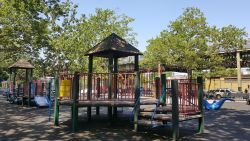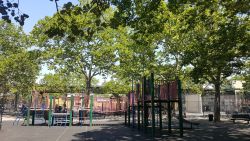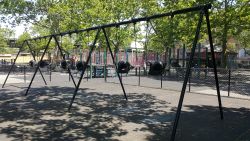Sankofa Park
Sankofa Park
What was here before?
During the 17th century the site housed the Dutch Reformed Church schoolhouse and cemetery. The “old cemetery” was established around 1680, and circumstantial evidence indicates some free and enslaved African Americans were buried here. The New Lots Dutch Reformed Church was built on the south side of New Lots Avenue in 1824 and established a new cemetery in 1840. The church abandoned the “old cemetery” by 1860 and moved some of their descendants to the new cemetery. Late 19th-century accounts speculated the move was due to the growing number of Black internments, which were likely on the northern end of the cemetery and developed by the African American community during the time of enslavement through the 18th century. The old burial ground continued to be utilized by the local Black community until the property was appropriated for a local school and associated playground around 1866.
Various incarnations of a community schoolhouse remained on this site until Public School No. 72 was built in 1886. By 1922, the City had converted the “old cemetery” area into a school playground.
How did this site become a park?
The school closed in 1944, and the footprint of the burial ground remained intact until 1953 when P.S. 72 was demolished and replaced by the New Lots Branch of the Brooklyn Public Library and a playground, which opened in 1956. The site was leveled with little awareness or regard to the burials. In 1987, the previously nameless playground was named Schenck Playground, after the politically prominent Schenck family who lived in the area in the 18th and 19th centuries and like many Dutch families, owned enslaved people.
In 2016, NYC Parks commissioned a series of archeological surveys, which unearthed fragmentary human remains. In July of 2019, community members held a ceremony to reinter the human remains found during the archeological surveys. At this event the site was renamed Sankofa Park in honor of the site’s African American history.
Plans for Sankofa Park include reconstruction of the playground and the creation of a new commemorative space with an oval lawn and circular stone assembly area for cultural and site education. The commemorative space will feature interpretive signage and landscape elements reminiscent of the site’s topography before it was razed in 1956. At its center, a stone inspired by the oration point for West African poets or storytellers, known as Griots, will allow for the tradition of the spoken word to continue.
Alongside the circle, a black granite marker inscribed with the Sankofa symbol, from the Adinkra alphabet, will identify the area where the human remains were reinterred. Other Adinkra symbols of West African culture are used in the park design. West African wax prints and the sharp angular lines of West African Kente Cloth provide guiding design elements within the park.
What is this park named for?
Both a word in the Akan Twi language of Ghana and a Bono Adinkra symbol, Sankofa refers to a mythic bird that flies into the future while keeping its beak turned toward the past. Its translation tells us that “it isn’t taboo to go back and fetch what you forgot.”
Check out your park's Vital Signs
Clean & Safe
Green & Resilient
Empowered & Engaged Users
Share your feedback or learn more about how this park is part of a
Vital Park System




